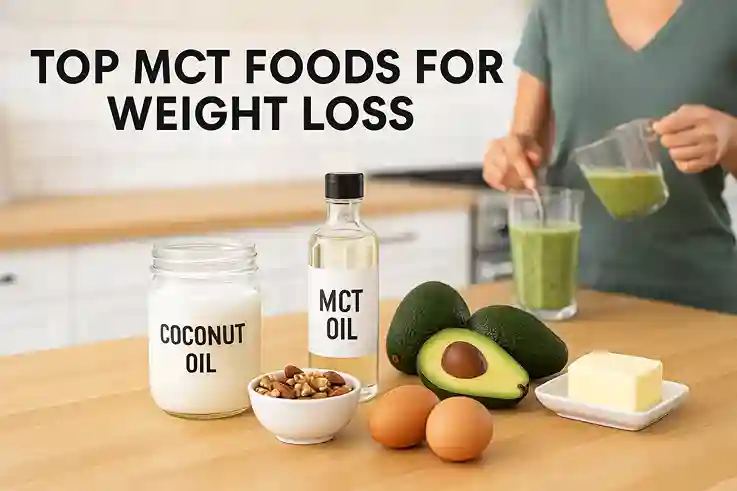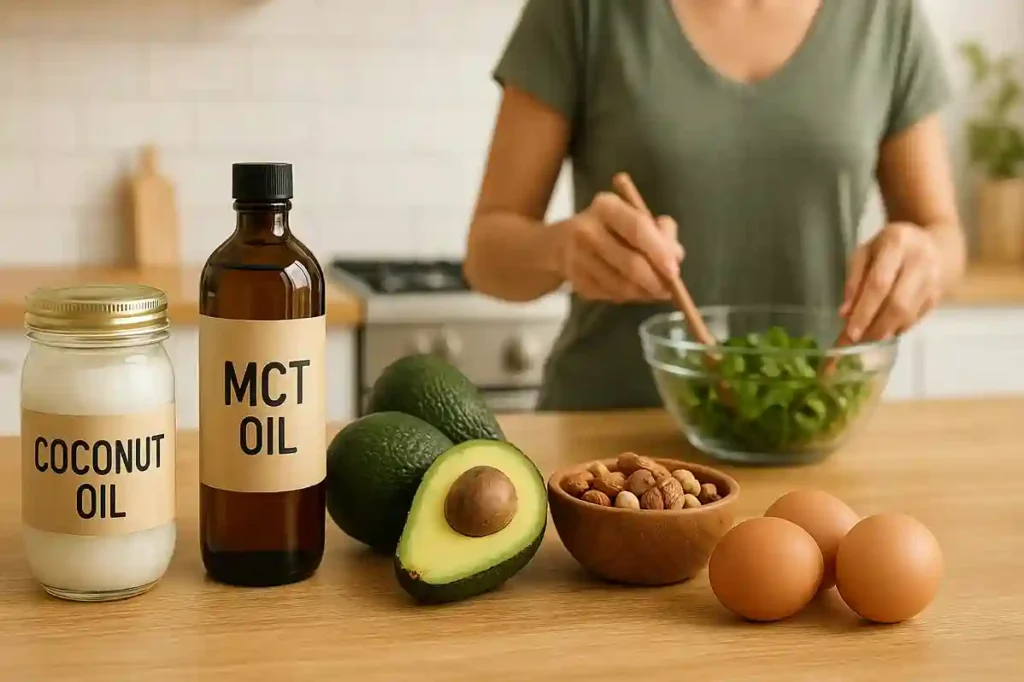MCT foods for weight loss support fat burning and gut health. MCTs, or medium-chain triglycerides, are fats your body digests quickly. Unlike long-chain fats, they move straight to the liver for energy use. This process helps reduce fat storage while fueling activity.
Americans are turning to MCTs because they want faster metabolism and better gut support. Busy lifestyles push many to search for simple, effective nutrition choices. MCT-rich foods fit into smoothies, coffee, or daily meals with ease.
The benefits are clear. MCTs encourage weight control, improve energy levels, and promote gut balance. With steady use, these fats may transform how you manage health and wellness.
What Are MCTs and Why They Matter

MCTs are medium-chain triglycerides, a unique form of dietary fat. They contain chains of 6 to 12 carbon atoms. This shorter structure changes how your body handles them.
Most fats in the American diet are long-chain triglycerides. These fats require bile salts and enzymes for digestion. After that, they travel through the lymphatic system before entering the bloodstream. The process is slow and energy release often delayed.
MCTs take a different path. They skip many digestive steps and move directly to the liver. The liver converts them into ketones, which act as a fast fuel for muscles and the brain. This rapid use helps reduce fat storage.
Think of butter compared to coconut oil. Butter contains mostly long-chain fats, so your body works harder to break it down. Coconut oil holds MCTs that turn into energy almost immediately. That difference explains why people link MCTs with weight loss and steady energy.
Top MCT Foods for Weight Loss
Coconut Oil
Coconut oil is one of the richest sources of MCTs. Nearly 60% of its fat content comes from medium-chain triglycerides. That makes it a strong choice for weight management and steady energy. You can stir it into coffee for a quick morning boost. Many people also drizzle it over roasted vegetables or mix it into oatmeal. Light cooking with coconut oil works well because it has a stable structure at medium heat.
Its mild, slightly sweet taste makes it an easy swap in American kitchens. Replacing other oils with coconut oil is a simple way to add more MCTs to daily meals.
MCT Oil
MCT oil is a concentrated option, and unlike coconut oil, it delivers almost pure medium-chain fats. As a result, you get quick energy without extra calories from other sources. For example, many people blend MCT oil into smoothies, shakes, or even coffee. This simple habit provides fast fuel and keeps hunger under control. Additionally, it supports metabolism and may help with fat burning.
However, beginners should start with small amounts. Otherwise, MCT oil can cause mild stomach upset. Over time, your body adjusts, and you can increase servings gradually.

Cheese, Butter, and Dairy
Cheese, butter, and dairy provide natural MCTs, and they fit easily into everyday meals. In fact, grass-fed butter and hard cheeses contain higher levels than regular dairy. Moreover, these foods add flavor and richness while delivering healthy fats. They can also support weight goals by keeping meals satisfying and reducing the urge to snack.
For instance, a slice of cheese with fruit or a pat of butter on steamed vegetables can boost taste and nutrition together. When chosen in moderation, dairy becomes both enjoyable and functional.
Avocado and Nuts
Avocado and nuts bring plant-based balance, and they still play a role in MCT foods for weight loss. While they are not as concentrated in MCTs as oils or dairy, they offer a valuable mix of healthy fats and fiber.
As a result, this combination helps reduce cravings and supports smooth digestion. Additionally, the fiber slows down energy release, which keeps you feeling full longer. For example, adding sliced avocado to a salad or a handful of nuts as a snack can stabilize appetite. These simple choices make plant-based fats an easy complement to more concentrated MCT sources.
Yogurt and Fermented Dairy
Yogurt and other fermented dairy combine MCTs with probiotics, making them a top choice in MCT foods for weight loss. This pairing works together to improve gut balance and deliver steady energy.
In addition, probiotics support the growth of healthy bacteria, while MCTs fuel digestion and metabolism. As a result, meals feel more satisfying and cravings often decrease.
For example, a bowl of plain yogurt topped with nuts and fruit provides both weight and gut benefits. It’s a simple, nutritious option that fits easily into the American diet and strengthens the role of MCT foods for weight loss.
Top MCT Foods for Weight Loss
| Food | MCT Role / Benefit | Easy Ways to Use |
|---|---|---|
| Coconut Oil | Richest natural source of MCTs; quick energy, supports fat burning | Stir into coffee, drizzle over veggies, cook at medium heat |
| MCT Oil | Concentrated pure MCTs; rapid fuel without extra calories | Blend into smoothies, shakes, or coffee (start small to avoid stomach upset) |
| Cheese & Butter | Natural dairy sources; add flavor and satiety | Use grass-fed butter on veggies, enjoy cheese slices with fruit |
| Avocado & Nuts | Plant-based fats with fiber; support appetite control | Add avocado to salads, eat a handful of nuts as snacks |
| Yogurt & Fermented Dairy | Combine probiotics with MCTs; improve gut health and digestion | Eat plain yogurt with nuts and fruit, try kefir as a drink |
Pilot feasibility and safety study examining the effect of medium chain triglyceride supplementation in subjects with mild cognitive impairment — this is hosted on the NIH’s PMC (National Library of Medicine) site
How MCT Foods for Weight Loss Boost Fat Burning

Thermogenic Effect
MCTs create a thermogenic effect, which means your body produces more heat during digestion. Because of this rise in heat, you naturally burn more calories compared to long-chain fats. Moreover, this calorie burn happens quickly since MCTs move straight to the liver. Over time, this process supports steady weight goals in a natural way.
Metabolism and Energy
In addition, MCTs move quickly to the liver, where they convert into ketones. These ketones act as a fast, clean fuel for both muscles and the brain. As a result, your body relies less on stored fat for energy spikes and more on steady fuel. Furthermore, a faster metabolism means your body uses calories more efficiently. This efficiency makes fat loss easier to sustain over time.
Appetite Control
MCTs also support appetite control, and this effect makes them valuable in daily nutrition. They provide steady energy, which helps prevent sudden drops in blood sugar. As a result, hunger spikes become less frequent.
Moreover, this steady fuel reduces cravings for processed snacks or sugary foods. When cravings decrease, overeating becomes less likely. Over time, this balance supports both weight management and better eating habits. Together, these effects explain why many people choose MCT foods for weight loss as part of a balanced diet.
MCT Foods and Gut Health
Fighting Harmful Bacteria
MCTs help protect the gut by fighting harmful bacteria, and this action keeps the digestive system in balance. They contain antimicrobial properties that work against certain pathogens such as Candida and Clostridium. As a result, these fats create an environment where harmful microbes struggle to grow.
Moreover, this protective effect reduces the risk of digestive discomfort and minor infections. With fewer harmful bacteria present, the gut can function more smoothly and support overall health.

Supporting Probiotics
In addition, MCTs support the growth of healthy probiotics in the gut, and this balance strengthens digestive health. Probiotics thrive when harmful bacteria are kept in check, creating space for beneficial strains to grow.
As a result, the gut becomes more efficient at absorbing nutrients from food. Moreover, this improved balance helps regulate digestion, reduce bloating, and maintain regular bowel movements. Over time, a strong probiotic community can also boost immune function.
Role of Fermented Foods
Fermented foods such as yogurt, kefir, and other cultured dairy combine probiotics with MCTs, creating a powerful gut health boost. Together, they strengthen digestion and make meals more effective at supporting nutrient absorption.
Moreover, the live cultures in fermented foods work with MCTs to keep the gut microbiome balanced. This partnership reduces bloating, improves regularity, and supports long-term digestive comfort.
When paired with MCT foods for weight loss, fermented foods also enhance metabolism and fat-burning potential. As a result, you get benefits for both weight management and gut function in one simple habit.
“MCT foods for weight loss don’t just fuel your body—they also feed your gut, energy, and balance.”
Easy Ways to Add MCT Foods Daily
Smoothies and Drinks
Smoothies are one of the simplest ways to add MCTs, and they fit well into busy mornings. A spoonful of coconut oil or MCT oil blends smoothly with fruit, greens, and protein powder. This small addition transforms a regular smoothie into a more filling, energy-boosting meal.
Likewise, many Americans stir MCT oil into their morning coffee. This practice, often called “bulletproof coffee,” delivers fast fuel without relying on sugar. As a result, energy stays steady and cravings fade.
With just a few adjustments, everyday drinks can become powerful sources of MCT foods for weight loss that support metabolism and gut health.
Salads and Cooking Oils
MCT-rich oils also work well in salads and light cooking, and they are easy to include in daily meals. For example, drizzle coconut oil over roasted vegetables to add both flavor and healthy fats. You can also whisk it into homemade dressings for a smooth texture and extra energy boost.
In addition, swapping regular butter with grass-fed butter or ghee brings natural MCTs to warm dishes. These choices add richness while improving the balance of fats in your diet. Moreover, they fit neatly into common American recipes without major changes.
With these small swaps, meals stay tasty and satisfying while providing steady support from MCT foods for weight loss.
Simple Meal Swaps
Replacing processed snacks with MCT-rich foods is another easy and practical option. Instead of chips or cookies, reach for a handful of nuts, a slice of cheese, or a serving of plain yogurt. Each of these choices delivers healthy fats along with better digestion support.
Moreover, these simple swaps reduce cravings and provide steady energy between meals. They also keep portions satisfying without relying on empty calories. Over time, these changes add up, making everyday eating patterns more balanced and supportive of long-term health.
By choosing smarter snacks, you can enjoy steady energy and appetite control while still benefiting from MCT foods for weight loss.
Tips for Busy Americans
Busy schedules often make healthy eating difficult, and many people turn to fast food when time runs short. However, portable options such as nut packs, yogurt cups, or avocado toast provide quick access to MCT foods for weight loss without extra effort.
In addition, preparing smoothie packs the night before can save valuable minutes in the morning. Just blend with water or milk, add MCT oil, and you have a ready-to-go breakfast. Likewise, keeping small containers of coconut oil or nut butter at work makes healthy snacking more convenient.
These simple strategies ensure that even on the busiest days, it’s possible to stay consistent with MCT-rich choices that support both weight management and gut health.
Precautions and Best Practices
Portion Size and Moderation
MCT foods offer many benefits, but portion size still matters for lasting results. Too much MCT oil or coconut oil can add excess calories quickly, which may stall weight goals instead of supporting them.
However, using the right amount allows you to enjoy the fat-burning effects without overdoing it. For most adults, a teaspoon to a tablespoon per serving is a safe and effective range. Starting small and adjusting as needed keeps MCT foods for weight loss both practical and sustainable
Digestive Sensitivity
Beginners may notice digestive sensitivity when first adding MCTs to their meals. Symptoms can include mild cramping, loose stools, or occasional bloating. These effects happen because the body is still adjusting to processing medium-chain fats more quickly.
To avoid discomfort, start with very small amounts of MCT oil or coconut oil. Gradually increase the serving size as your system adapts. Over time, the body adjusts, and these early side effects usually fade. With a slow approach, MCT foods for weight loss become easier to enjoy without digestive stress.
Balance With Whole Foods
MCTs should complement—not replace—other nutritious foods in the diet. Whole grains, lean proteins, fruits, and vegetables remain essential for long-term health and wellness. Each food group contributes vitamins, minerals, and fiber that MCTs alone cannot provide.
Moreover, pairing MCT foods for weight loss with a variety of whole foods creates a balanced approach. This mix ensures steady weight control, stronger digestion, and more reliable energy throughout the day. In the end, balance makes MCTs a supportive tool rather than the only focus of your meals.
Balance With Whole Foods
MCTs should complement—not replace—other nutritious foods in the diet. Whole grains, lean proteins, fruits, and vegetables remain essential for long-term health and wellness. Each food group contributes vitamins, minerals, and fiber that MCTs alone cannot provide.
Moreover, pairing MCT foods for weight loss with a variety of whole foods creates a balanced approach. This mix ensures steady weight control, stronger digestion, and more reliable energy throughout the day.
For example, a balanced plate might include grilled chicken for protein, roasted vegetables for fiber, quinoa for complex carbs, and sliced avocado for healthy fats. Adding a light drizzle of coconut oil ties the meal together while boosting MCT content. This simple strategy blends variety with function, making MCTs a supportive tool instead of the only focus.
Sample One-Day Meal Plan with MCT Foods
| Meal | Example Plate / Drink | MCT Source | Extra Benefits |
|---|---|---|---|
| Breakfast | Smoothie with spinach, berries, protein powder, and 1 tsp MCT oil | MCT oil | Fast fuel, appetite control |
| Snack | Plain yogurt with nuts and sliced fruit | Yogurt + nuts | Gut probiotics + fiber |
| Lunch | Grilled chicken, quinoa, roasted veggies, avocado slices, drizzle of coconut oil | Coconut oil + avocado | Balanced energy, healthy fats |
| Snack | Cheese cubes with apple slices | Cheese | Protein + satiety |
| Dinner | Salmon with brown rice, steamed broccoli, and a side of sautéed greens in ghee | Ghee | Nutrient absorption, steady energy |
FAQs About MCT Foods for Weight Loss
Conclusion
MCT foods for weight loss offer more than just fat-burning support. They provide quick energy, reduce cravings, and improve gut balance. From coconut oil in coffee to yogurt with nuts, these foods fit easily into the American diet. However, moderation matters. Small portions, paired with whole grains, proteins, fruits, and vegetables, create the best results. By making simple swaps and balanced choices, you can enjoy steady energy, better digestion, and lasting weight control. In the end, MCTs work best as part of a healthy lifestyle, not as a shortcut. Try adding them to your meals, notice how your body responds, and adjust as needed.
What do you think—will you start experimenting with MCT foods in your daily routine? Share your thoughts or experiences in the comments below.

Adi holds a B.Sc. in Hospitality Management from the Institute of Hotel Management, bringing both academic knowledge and real-world experience to the table. Passionate about food, flavor, and the stories behind every dish, Adi writes to make culinary concepts approachable for everyone. From exploring global cuisines to highlighting simple kitchen techniques, the goal is always the same—help readers enjoy food more deeply and cook with confidence.


